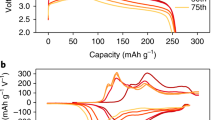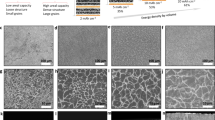Abstract
Lithium manganese oxide, LiMn2O4 (LMO) is a promising cathode material, but is hampered by significant capacity fade due to instability of the electrode-electrolyte interface, manganese dissolution into the electrolyte and subsequent mechanical degradation of the electrode. In this work, electrochemically-induced strains in composite LMO electrodes are measured using the digital image correlation (DIC) technique and compared with electrochemical impedance spectroscopy (EIS) measurements of surface resistance for different scan rates. Distinct, irreversible strain variations are observed during the first delithiation cycle. The changes in strain and surface resistance are highly sensitive to the electrochemical changes occurring during the first cycle and correlate with prior reports of the removal of the native surface layer and the formation of cathode-electrolyte interface layer on the electrode surface. A large capacity fade is observed with increasing cycle number at high scan rates. Interestingly, the total capacity fade scales proportionately to the strain generated after each lithiation and delithiation cycle. The simultaneous reduction in capacity and strain is attributed to chemo-mechanical degradation of the electrode. The in situ strain measurements provide new insight into the electrochemical-induced volumetric changes in LMO electrodes with progressing cycling and may provide guidance for materials-based strategies to reduce strain and capacity fade.













Similar content being viewed by others
References
Tavassol H, Jones EMC, Sottos NR, Gewirth AA (2016) Electrochemical stiffness in lithium-ion batteries. Nat Mater 15:1182–1187. https://doi.org/10.1038/nmat4708
Çapraz ÖÖ, Bassett KL, Gewirth AA, Sottos NR (2016) Electrochemical stiffness changes in lithium manganese oxide electrodes. Adv Energy Mater:1601778–1601777. https://doi.org/10.1002/aenm.201601778
Mukhopadhyay A, Sheldon BW (2014) Deformation and stress in electrode materials for li-ion batteries. Prog Mater Sci 63:58–116. https://doi.org/10.1016/j.pmatsci.2014.02.001
Peled E, Golodnitsky D, Ardel G (1997) Advanced model for solid electrolyte interphase electrodes in liquid and polymer electrolytes. J Electrochem Soc 144:L208–L210. https://doi.org/10.1149/1.1837858
Zhang S, Ding MS, Xu K et al (2001) Understanding solid electrolyte Interface film formation on graphite electrodes. Electrochem Solid-State Lett 4:A206–A208. https://doi.org/10.1149/1.1414946
Jones EMC, Çapraz ÖÖ, White SR, Sottos NR (2016) Reversible and irreversible deformation mechanisms of composite graphite electrodes in lithium-ion batteries. J Electrochem Soc 163:A1965–A1974. https://doi.org/10.1149/2.0751609jes
Vidu R, Quinlan FT, Stroeve P (2002) Use of in situ electrochemical atomic force microscopy (EC-AFM) to monitor cathode surface reaction in organic electrolyte. Ind Eng Chem Res 41:6546–6554. https://doi.org/10.1021/ie020519z
Aurbach D (1998) Common electroanalytical behavior of li intercalation processes into graphite and transition metal oxides. J Electrochem Soc 145:3024–3034. https://doi.org/10.1149/1.1838758
Das SR, Majumder SB, Katiyar RS (2005) Kinetic analysis of the li+ ion intercalation behavior of solution derived nano-crystalline lithium manganate thin films. J Power Sour. https://doi.org/10.1016/j.jpowsour.2004.06.056
Beaulieu LY, Eberman KW, Turner RL et al (2001) Colossal reversible volume changes in lithium alloys. Electrochem Solid-State Lett 4:A137–A140. https://doi.org/10.1149/1.1388178
Liu XH, Huang JY (2011) In situ TEM electrochemistry of anode materials in lithium ion batteries. Energy Environ Sci 4:3844–3860. https://doi.org/10.1039/c1ee01918j
Timmons A, Dahn JR (2006) In situ optical observations of particle motion in alloy negative electrodes for li-ion batteries. J Electrochem Soc 153:A1206–A1210. https://doi.org/10.1149/1.2194611
Qi Y, Harris SJ (2010) In situ observation of strains during Lithiation of a graphite electrode. J Electrochem Soc 157:A741–A747. https://doi.org/10.1149/1.3377130
Jones EMC, Silberstein MN, White SR, Sottos NR (2014) In situ measurements of strains in composite battery electrodes during electrochemical cycling. Exp Mech 54:971–985. https://doi.org/10.1007/s11340-014-9873-3
Gonzalez J, Sun K, Huang M et al (2014) Three dimensional studies of particle failure in silicon based composite electrodes for lithium ion batteries. J Power Sour 269:334–343. https://doi.org/10.1016/j.jpowsour.2014.07.001
Eastwood DS, Yufit V, Gelb J et al (2013) Lithiation-induced dilation mapping in a lithium-ion battery electrode by 3D X-ray microscopy and digital volume correlation. Adv Energy Mater 4:1300506–1300507. https://doi.org/10.1002/aenm.201300506
Wang H, Jang Il Y, Huang B et al (1999) TEM study of electrochemical cycling-induced damage and disorder in LiCoO2 cathodes for rechargeable lithium batteries. J Electrochem Soc 146:473–480
Dokko K, Nishizawa M, Horikoshi S, Itoh T (2000) In situ observation of LiNiO2 single-particle fracture during li-ion extraction and insertion. Electrochem solid-state Lett 3:125–127
Zhang Z, Chen Z, Wang G et al (2016) Dual-doping to suppress cracking in spinel LiMn2O4: a joint theoretical and experimental study. Phys Chem Chem Phys 18:6893–6900. https://doi.org/10.1039/c5cp07182h
Wang D, Wu X, Wang Z, Chen L (2005) Cracking causing cyclic instability of LiFePO4 cathode material. J Power Sour 140:125–128. https://doi.org/10.1016/j.jpowsour.2004.06.059
Julien, CM, Mauger A, Zaghib K, Groult, H (2014) Comparative issues of cathode materials for Li-ion batteries. Inorganics 2:132-154, https://doi.org/10.3390/inorganics2010132
Xu X, Lee S, Jeong S et al (2013) Recent progress on nanostructured 4 V cathode materials for li-ion batteries for mobile electronics. Mater Today 16:487–495. https://doi.org/10.1016/j.mattod.2013.11.021
Hausbrand R, Cherkashinin G, Ehrenberg H et al (2015) Fundamental degradation mechanisms of layered oxide li-ion battery cathode materials: methodology, insights and novel approaches. Materials Science & Engineering B 192:3–25. https://doi.org/10.1016/j.mseb.2014.11.014
Etacheri V, Marom R, Elazari R et al (2011) Challenges in the development of advanced li-ion batteries: a review. Energy Environ Sci 4:3243–3220. https://doi.org/10.1039/c1ee01598b
Sun X, Yang XQ, Balasubramanian M et al (2002) In situ investigation of phase transitions of Li1+yMn2O4 spinel during li-ion extraction and insertion. J Electrochem Soc 149(7):A842. https://doi.org/10.1149/1.1481523
Qi Y, Hector LG, James C, Kim KJ (2014) Lithium concentration dependent elastic properties of battery electrode materials from first principles calculations. J Electrochem Soc 161:F3010–F3018. https://doi.org/10.1149/2.0031411jes
Edström K, Gustafsson T, Thomas JO (2004) The cathode–electrolyte interface in the li-ion battery. Electrochim Acta 50:397–403. https://doi.org/10.1016/j.electacta.2004.03.049
Aurbach D, Levi MD, Gamulski K et al (1999) Capacity fading of LiMn2O4 spinel electrodes studies by XRD and electroanalytical techniques. J Power Sour 81:472–479
Aurbach D, Talyosef Y, Markovsky B et al (2004) Design of electrolyte solutions for li and li-ion batteries: a review. Electrochim Acta 50:247–254. https://doi.org/10.1016/j.electacta.2004.01.090
Aurbach D, Markovsky B, Salitra G et al (2007) Review on electrode–electrolyte solution interactions, related to cathode materials for li-ion batteries. J Power Sour 165:491–499. https://doi.org/10.1016/j.jpowsour.2006.10.025
Eriksson T, Andersson AM, Bishop AG et al (2002) Surface analysis of LiMn2O4 electrodes in carbonate-based electrolytes. J Electrochem Soc 149:A69–A78. https://doi.org/10.1149/1.1426398
Eriksson T, Gustafsson T, Thomas JO (2002) Surface structure of LiMn2O4 electrodes. Electrochem Solid-State Lett 5:A35–A34. https://doi.org/10.1149/1.1432782
Xu K (2004) Nonaqueous liquid electrolytes for lithium-based rechargeable batteries. Chem Rev 104:4303–4418. https://doi.org/10.1021/cr030203g
Chung KY, Yoon W-S, Kim K-B et al (2011) Formation of an SEI on a LiMn2O4 cathode during room temperature charge–discharge cycling studied by soft X-ray absorption spectroscopy at the fluorine K-edge. J Appl Electrochem 41:1295–1299. https://doi.org/10.1007/s10800-011-0344-6
Aurbach D, Gamolsky K, Markovsky B et al (2000) The study of surface phenomena related to electrochemical lithium intercalation into lix MO y host materials (M = Ni, Mn). J Electrochem Soc 147:1322–1331. https://doi.org/10.1149/1.1393357
Tavassol H, Chan MKY, Catarello MG et al (2013) Surface coverage and SEI induced electrochemical surface stress changes during li deposition in a model system for li-ion battery anodes. J Electrochem Soc 160:A888–A896. https://doi.org/10.1149/2.068306jes
Wang JW, He Y, Fan F et al (2013) Two-phase electrochemical Lithiation in amorphous silicon. Nano Lett 13:709–715. https://doi.org/10.1021/nl304379k
Paz-Garcia JM, Taiwo OO, Tudisco E et al (2016) 4D analysis of the microstructural evolution of Si-based electrodes during lithiation: time-lapse X-ray imaging and digital volume correlation. J Power Sour 320:196–203. https://doi.org/10.1016/j.jpowsour.2016.04.076
Nation L, Li J, James C et al (2017) In situ stress measurements during electrochemical cycling of lithium-rich cathodes. J Power Sour 364:383–391. https://doi.org/10.1016/j.jpowsour.2017.08.006
Sheth J, Karan NK, Abraham DP et al (2016) In situ stress evolution in li 1+xMn 2O 4Thin films during electrochemical cycling in li-ion cells. J Electrochem Soc 163:A2524–A2530. https://doi.org/10.1149/2.0161613jes
Cho H-M, Chen MV, MacRae AC, Meng YS (2015) Effect of surface modification on Nano-structured LiNi0.5Mn1.5O4 spinel materials. ACS Appl Mater Interfaces 7:16231–16239. https://doi.org/10.1021/acsami.5b01392
Ho C (1980) Application of A-C techniques to the study of lithium diffusion in tungsten trioxide thin films. J Electrochem Soc 127:343–350. https://doi.org/10.1149/1.2129668
Xie J, Kohno K, Matsumura T et al (2008) Li-ion diffusion kinetics in LiMn2O4 thin films prepared by pulsed laser deposition. Electrochim Acta 54:376–381. https://doi.org/10.1016/j.electacta.2008.07.067
Goonetilleke PC, Zheng JP, Roy D (2009) Effects of surface-film formation on the electrochemical characteristics of LiMn2O4 cathodes of lithium ion batteries. J Electrochem Soc 156:A709–A719. https://doi.org/10.1149/1.3155432
Zheng J, Sulyma C, Goia C et al (2012) Electrochemical features of ball-milled lithium manganate spinel for rapid-charge cathodes of lithium ion batteries. J Solid State Electrochem 16:2605–2615. https://doi.org/10.1007/s10008-012-1677-8
Ploehn HJ, Ramadass P, White RE (2004) Solvent diffusion model for aging of lithium-ion battery cells. J Electrochem Soc 151:A456–A462. https://doi.org/10.1149/1.1644601
Smith AJ, Burns JC, Zhao X et al (2011) A high precision Coulometry study of the SEI growth in li/graphite cells. J Electrochem Soc 158:A447–A452. https://doi.org/10.1149/1.3557892
Lu CH, Lin SW (2002) Dissolution kinetics of spinel lithium manganate and its relation to capacity fading in lithium ion batteries. J Mater Res. https://doi.org/10.1557/JMR.2002.0219
Jang DH, Shin YJ, Oh SM (1996) Dissolution of spinel oxides and capacity losses in 4 V li / li x Mn2 O 4 cells. J Electrochem Soc 143:2204–2211. https://doi.org/10.1149/1.1836981
Miller DJ, Proff C, Wen JG et al (2013) Observation of microstructural evolution in li battery cathode oxide particles by in situ electron microscopy. Adv Energy Mater 3:1098–1103. https://doi.org/10.1002/aenm.201300015
Cheng Y-T, Verbrugge MW (2008) The influence of surface mechanics on diffusion induced stresses within spherical nanoparticles. J Appl Phys. https://doi.org/10.1063/1.3000442
Zhao K, Pharr M, Vlassak JJ, Suo Z (2010) Fracture of electrodes in lithium-ion batteries caused by fast charging. J Appl Phys 108(7):073517. https://doi.org/10.1063/1.3492617
Acknowledgements
This work was supported as part of the Center for Electrochemical Energy Science, an Energy Frontier Research Center funded by the U. S. Department of Energy, Office of Science, Basic Energy Sciences. The authors would like to acknowledge the Beckman Institute for Advanced Science and Technology for use of microscopy equipment and Dr. Joseph Lyding for use of spot welding equipment.
Author information
Authors and Affiliations
Corresponding author
Rights and permissions
About this article
Cite this article
Çapraz, Ö.Ö., Rajput, S., White, S. et al. Strain Evolution in Lithium Manganese Oxide Electrodes. Exp Mech 58, 561–571 (2018). https://doi.org/10.1007/s11340-018-0381-8
Received:
Accepted:
Published:
Issue Date:
DOI: https://doi.org/10.1007/s11340-018-0381-8




